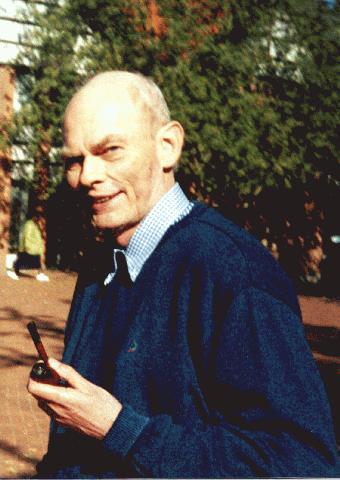
Hello!
- My name is Peder Voetmann Christiansen, born 1939. I live in Lejre in central Zealand (Leidhra, the ancient capital of danish saga-kings) I work as an associate professor of physics at Roskilde University, but I'm now partly retired after a stroke I had in 1997 I have four sons, Morten, Jesper, Frederik, and Harald, with my first wife, Susanne, who died in 1992. Now, I'm happily married for the second time with Else, who has two daughters, Hanne and Mette.
Professional career.
- I graduated in Physics from Copenhagen University in 1964. My master's thesis was about mechanical proofs of Boltzmann's H-theorem. I started as a lecturer in Electrodynamics, Quantum Chemistry, and Statistical Mechanics in 1970. Later, I have lectured in Quantum Mechanics and Solid State Physics at the Niels Bohr Institute in Copenhagen. In 1985 I moved to the rather new university in Roskilde where I have taught various subjects within physics, such as Classical Mechanics, Relativity Theory, Quantum Mechanics, and Thermodynamics, and a lot of cross-disciplinary projects where physics has been combined with other subjects, such as philosophy, history, biology, and agriculture.
My scientific production (see list of publications, 64-99) can be roughly described as a slow transition from physics to metaphysics. My first papers dealt with the phenomenological Ginzburg-Landau theory of superconductivity. Later (1970) I started a new course "Ecophysics" which combined ecological energetics with non-equilibrium thermodynamics, Information Theory, and Cybernetics. In this connection I began to write more philosophically about subjects as Entropy, Information, and Time. I was very interested in the debate about the book "Limits to Growth" and started to work with diagrammatic representations of dynamic models of ecosystems. I thereby began to study the philosophy and semiotic of C.S. Peirce, (now at arisbe Ed.) and for some years I fparticipated eagerly in the discussions on the Peirce-list and published an annotated danish translation of 5 of Peirce's metaphysical papers (The Monist, 1891-93).
For dynamic modelling I used a technique, of energy-bond-graphs developed by H.M. Paynter, M.I.T., based on Peirce's semiotic. My semiotics-interest also led me to symbolic logic and logical paradoxes. The bond-graph-technique proved to be a main road to the foundations of modern physics, including Relativity and Quantum Mechanics, and I began to envisage a new discipline "Quantum Semiotic" to tackle the basic philosophical problems of Quantum Mechanics. I was also interested in the historical connections to philosophy in Bohr's "Copenhagen Interpretation" of Quantum Mechanics and wrote a newspaper chronicle about it on the occasion of Bohr's 100 years anniversary, october 1985. Lately, my interest in the Copenhagen interpretation and alternatives has resulted in a danish paper about the metaphysical challenge in an alternative interpretation, the "Many Worlds" and a critique of it. My interst in Peirce and Semiotics has led to contact with people in various other fields. I have contact with biologists Jesper Hoffmeyer and Claus Emmeche through membership of the Danish Society for Nature's Semiotic (DaSeNaSe) and have co-edited a collection of papers on the philosophical subjects of Emergence and Downward Causation (see publications 1999, see also this).
Quantum Semiotic
- The subject of Quantum Semiotic (QS) can be shortly defined as an energy- bond-graph-reticulation of Peirce's sign relation I-R-O, where O stands for the Object, R for the Representamen, and I for the Interpretant. A short "axiomatic" presentation of the basic ideas can be found in this paper. As the bond graph technique is explicitly local the first prediction of QS was that Quantum Mechanical Non-Locality was due to a misinterpretation of the violation of Bell's inequalities. My first prediction was falsified by Aspect's "switching" experiment in 1982, but I soon got the idea that the observed violation of Bell could be explained by contextuality in a purely local way by the connections to pre-set coincidence counters. I therefore proposed an experiment without these counters i.e. with "retrospective coincidence counting" based on accurate timings of the arrivals of the separated particles, and I expected Bell's inequalities to be satisfied under these circumstances. Such an experiment was made by the "experimental metaphysics group" in Innsbruck (G. Weihs, A. Zeilinger et al.) in the spring of 1998, and, again, my idea was falsified by a convincing violation of Bell's inequalities. So, I've now had to admit that non- locality has a place in Quantum Mechanics, but I haven't given up my ambitions of developing QS, because I soon realized that non-locality, as well as quantization and collapse can be naturally explained by the bond-graph technique. In the years to come I hope to be able to present QS in a convincing way.
"My heart is always restly
From the clear daylight till the dawn
But some day I may be able
To plough the rocks of Bawn.
(Robin Williamson)
Online papers and publications
- Publikationer 1964-'99
- Springet fra København
- Mit yndlingsparadoks: Portias portręt
- Den metafysiske udfordring
- Axioms of Quantum Semiotic
- Quantum Semiotic and Interaction Bond Graphs
- Peircean local realism does not imply Bell's inequalities.
- The concept of emergence and the Peircean categories

Top of page